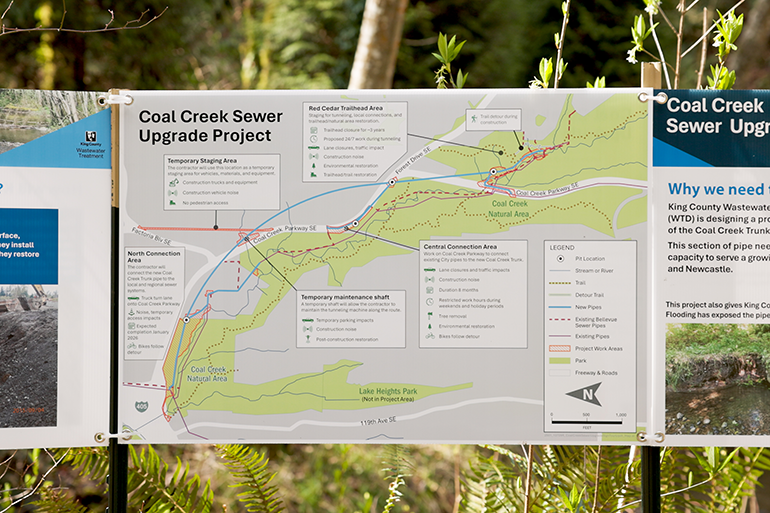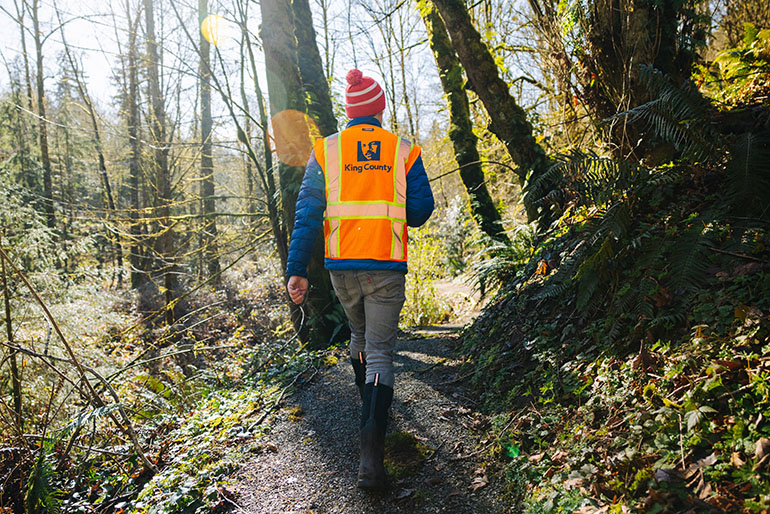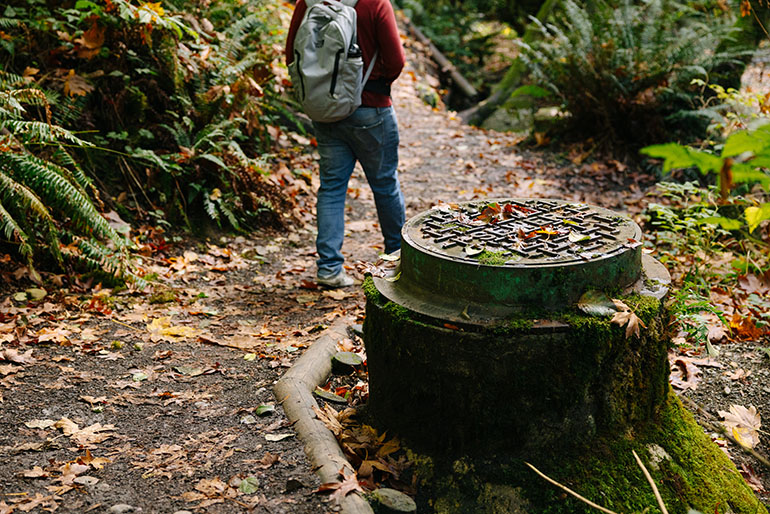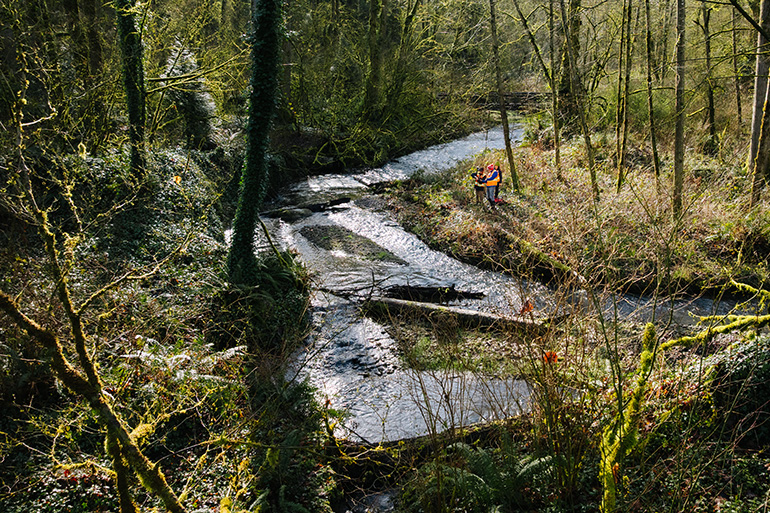King County’s major sewer upgrade in Bellevue is the first project of its kind to earn Salmon-Safe certification, simultaneously modernizing infrastructure and improving habitat
Summary
April 9, 2025: One of the nation’s leading eco-labels, Salmon-Safe, has awarded its first ever certification for a wastewater infrastructure project to King County’s Coal Creek Sewer Upgrade in Bellevue.
News
King County’s major sewer upgrade in Bellevue is the first infrastructure project of its kind to earn Salmon-Safe certification, simultaneously modernizing essential wastewater infrastructure for a growing population, improving habitat for fish and wildlife, and increasing access to nature for people of all abilities.
Salmon-Safe, one of the nation’s leading eco-labels, reviewed the stream design developed by the King County Wastewater Treatment Division as part of their performance-based certification process. Replacing nearly 2 miles of sewer pipeline will better serve growing populations in Bellevue and Newcastle.
Designing capital projects that produce multiple benefits for people, fish, and wildlife is a fundamental principle of Clean Water Healthy Habitat, an initiative former King County Executive Dow Constantine launched in 2019.
“Modernizing critical infrastructure, improving salmon habitat, and enhancing popular trails is a lasting legacy of Executive Constantine’s approach to public investments,” said King County Executive Shannon Braddock. “We will build on that solid foundation to continue producing benefits for people, fish, and wildlife.”


The 5-year project, scheduled to begin this spring, will build on improvements the City of Bellevue has made along its Red Cedar Trailhead to make the popular urban hiking trail more accessible. The trailhead will be improved to standards under the Americans with Disabilities Act to include benches, a wider trail with surfacing for wheelchairs and strollers, and a Braille trail with tactile signage.
The current sewer line, installed in the 1960s, is nearing its capacity to serve growing Eastside communities. It crosses under the creek in multiple locations, generally following the creek through the Coal Creek Natural Area with multiple maintenance holes.
The new pipeline will largely bypass the natural area while much of the existing pipeline will be safely decommissioned and left in place to minimize disruption. Crews will remove portions of the pipeline that are in the creek, plant native vegetation, and add woody debris to restore ecological functions. The project design incorporated input from the Muckleshoot Indian Tribe, the Washington Department of Fish and Wildlife, the City of Bellevue, and the neighboring community.


“The Coal Creek Sewer Upgrade project is a perfect example of how we can achieve our environmental goals at the same time we improve quality of life for King County residents,” said Claudia Balducci, King County Councilmember and Chair of the Regional Water Quality Committee. “The Coal Creek Natural Area is one of our most popular outdoor recreation areas and provides critical habitat for wildlife, including our precious salmon. This project is one more way we can protect and preserve this beautiful, ecologically important place for generations to come.”
“The Coal Creek Sewer Upgrade project is a critical investment in our region’s future and reflects our commitment to sustainability and public health,” said Kamuron Gurol, Director of the Wastewater Treatment Division. “By replacing aging infrastructure with a modern, more resilient system, we’re ensuring reliable wastewater service for residents while enhancing a salmon-bearing creek and the surrounding environment.”
Salmon-Safe offers peer-reviewed certification to West Coast farmers, developers, and other land stewards in both urban and rural areas who want to reduce their impact on watersheds. Salmon-Safe’s science team was particularly impressed by the Wastewater Treatment Division’s project design that not only reduces the impact on the surrounding environment but enhances it. The project meets Salmon-Safe standards for construction stormwater management, stream flow management during construction, water quality protection, and invasive species management.
The $96.5 million project will also restore and expand existing wetlands, add fencing to protect native understory and tree canopy to keep creek water cool and clean for salmon, and install interpretive signage along the trail.
The Salmon-Safe certification is valid for five years and is subject to annual reviews. The Wastewater Treatment Division will continue to work with the Portland-based nonprofit to ensure the project meets the conditions of certification.
"The Coal Creek Sewer Upgrade project demonstrates how essential infrastructure can be designed and constructed to restore watershed health,” said Ella Sandquist, Director of Salmon-Safe Puget Sound. “We applaud the team behind the project for integrating innovative, fish-friendly design and management practices.”
The new pipeline will be steered away from Coal Creek using a tunneling machine to reduce the impact above ground.
Work performed in the creek will be limited to three-month windows during summer months to minimize the impact on salmon and neighbors. A portion of the Coal Creek Natural Area hiking trail will be inaccessible for at least three years, though an alternative trail will be available. Once the project is complete, the City of Bellevue will resume management of the restored areas.
"We are thrilled to partner with King County on this vital wastewater project, which will also protect Coal Creek's ability to support salmon and other wildlife,” said Bellevue Mayor Lynne Robinson. “Additionally, we are committed to creating recreational spaces that are inclusive and sustainable, ensuring they can be enjoyed by future generations."
The Wastewater Treatment Division is one of four divisions at the King County Department of Natural Resources and Parks. Another division, King County Parks, is the largest park agency in the nation to earn Salmon-Safe certification.
“To have two of our divisions earn Salmon-Safe certification demonstrates our staff’s commitment and ability to achieve multiple benefits for people, fish, and wildlife,” said John Taylor, Director of the Department of Natural Resources and Parks. “Having independent experts conduct a rigorous, ongoing review of our project design ensures that our capital projects produce the results we all want to see.”
Modernizing critical infrastructure, improving salmon habitat, and enhancing popular trails is a lasting legacy of Executive Constantine’s approach to public investments. We will build on that solid foundation to continue producing benefits for people, fish, and wildlife.
The Coal Creek Sewer Upgrade project is a perfect example of how we can achieve our environmental goals at the same time we improve quality of life for King County residents. The Coal Creek Natural Area is one of our most popular outdoor recreation areas and provides critical habitat for wildlife, including our precious salmon. This project is one more way we can protect and preserve this beautiful, ecologically important place for generations to come.
The Coal Creek Sewer Upgrade project demonstrates how essential infrastructure can be designed and constructed to restore watershed health. We applaud the team behind the project for integrating innovative, fish-friendly design and management practices.
We are thrilled to partner with King County on this vital wastewater project, which will also protect Coal Creek's ability to support salmon and other wildlife. Additionally, we are committed to creating recreational spaces that are inclusive and sustainable, ensuring they can be enjoyed by future generations.
To have two of our divisions earn Salmon-Safe certification demonstrates our staff’s commitment and ability to achieve multiple benefits for people, fish, and wildlife. Having independent experts conduct a rigorous, ongoing review of our project design ensures that our capital projects produce the results we all want to see.
The Coal Creek Sewer Upgrade project is a critical investment in our region’s future and reflects our commitment to sustainability and public health. By replacing aging infrastructure with a modern, more resilient system, we’re ensuring reliable wastewater service for residents while enhancing a salmon-bearing creek and the surrounding environment.

 Translate
Translate